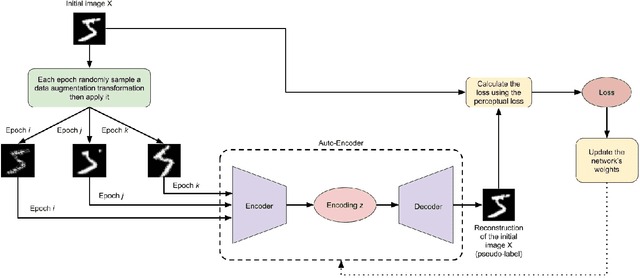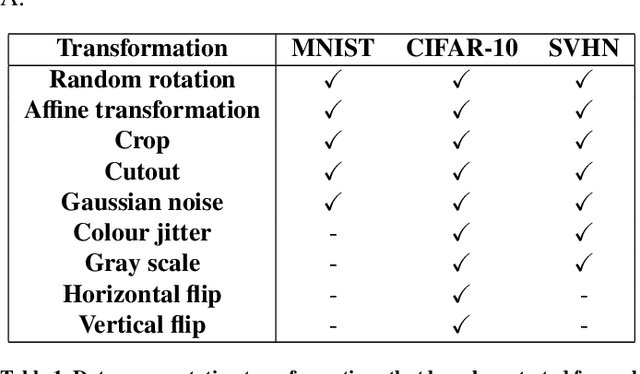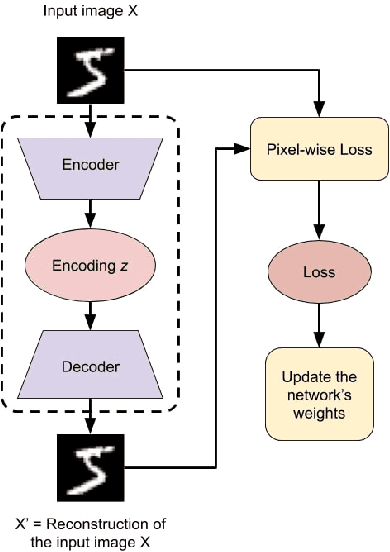Rachid Deriche
Improving Auto-Encoders' self-supervised image classification using pseudo-labelling via data augmentation and the perceptual loss
Dec 06, 2020



Abstract:In this paper, we introduce a novel method to pseudo-label unlabelled images and train an Auto-Encoder to classify them in a self-supervised manner that allows for a high accuracy and consistency across several datasets. The proposed method consists of first applying a randomly sampled set of data augmentation transformations to each training image. As a result, each initial image can be considered as a pseudo-label to its corresponding augmented ones. Then, an Auto-Encoder is used to learn the mapping between each set of the augmented images and its corresponding pseudo-label. Furthermore, the perceptual loss is employed to take into consideration the existing dependencies between the pixels in the same neighbourhood of an image. This combination encourages the encoder to output richer encodings that are highly informative of the input's class. Consequently, the Auto-Encoder's performance on unsupervised image classification is improved both in termes of stability and accuracy becoming more uniform and more consistent across all tested datasets. Previous state-of-the-art accuracy on the MNIST, CIFAR-10 and SVHN datasets is improved by 0.3\%, 3.11\% and 9.21\% respectively.
Regularized Spherical Polar Fourier Diffusion MRI with Optimal Dictionary Learning
Jul 02, 2013

Abstract:Compressed Sensing (CS) takes advantage of signal sparsity or compressibility and allows superb signal reconstruction from relatively few measurements. Based on CS theory, a suitable dictionary for sparse representation of the signal is required. In diffusion MRI (dMRI), CS methods were proposed to reconstruct diffusion-weighted signal and the Ensemble Average Propagator (EAP), and there are two kinds of Dictionary Learning (DL) methods: 1) Discrete Representation DL (DR-DL), and 2) Continuous Representation DL (CR-DL). DR-DL is susceptible to numerical inaccuracy owing to interpolation and regridding errors in a discretized q-space. In this paper, we propose a novel CR-DL approach, called Dictionary Learning - Spherical Polar Fourier Imaging (DL-SPFI) for effective compressed-sensing reconstruction of the q-space diffusion-weighted signal and the EAP. In DL-SPFI, an dictionary that sparsifies the signal is learned from the space of continuous Gaussian diffusion signals. The learned dictionary is then adaptively applied to different voxels using a weighted LASSO framework for robust signal reconstruction. The adaptive dictionary is proved to be optimal. Compared with the start-of-the-art CR-DL and DR-DL methods proposed by Merlet et al. and Bilgic et al., espectively, our work offers the following advantages. First, the learned dictionary is proved to be optimal for Gaussian diffusion signals. Second, to our knowledge, this is the first work to learn a voxel-adaptive dictionary. The importance of the adaptive dictionary in EAP reconstruction will be demonstrated theoretically and empirically. Third, optimization in DL-SPFI is only performed in a small subspace resided by the SPF coefficients, as opposed to the q-space approach utilized by Merlet et al. The experiment results demonstrate the advantages of DL-SPFI over the original SPF basis and Bilgic et al.'s method.
 Add to Chrome
Add to Chrome Add to Firefox
Add to Firefox Add to Edge
Add to Edge